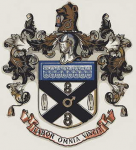Makemakean
Mr Makemean
- Pronouns
- Logical, unlike those in German

That embroidery looks fab
Thanks!
More than half of the time and effort expended on the picture was put on that. I really hope I won't have to draw any more embroidery any time soon.
I had the same experience doing Long Eaton UDC's coat of arms. They'd put *lace* on it!
That is some fine work with the mantling, I must say.


The idea for him was entirely based on me once seeing a photo of John A. Costello, and thinking to myself "Boy, that man looks tired! Like they woke him in the middle of the night and told him he has to become Taoiseach and he kind of would have preferred if he would have been happier if he had been allowed to sleep instead and never become Taoiseach!"
John A. Costello always looked like that tbf.When a while ago when I was doing Chancery Presidents of the Nordic Empire, I was trying to draw up some basic idea of what happens after the Chancery Presidency of Hjalmar Montelius. I didn't get particularly far. I have no idea even what the broad outlines are. I have some idea of various characters I want to include, like Thorsager Brandstrup, the first Labour Chancery President, Sigurd Meisner, the Professor of Statistics who becomes Liberal Chancery President in the early 20th century, Sven Tigerstedt, the last Skeptical Chancery President who runs a caretaker ministry in the 1930s, Brynhildur Þórmundsdóttir, the current Nordic Chancery President (well, err-... the Chancery President at the middle of the 2010s, at least), Pekka Elias Lammikko, who serves as Chancery President in the 1970s (basically a Finnish Pierre Trudeau), and of course I have one idea for Norvald Espenssen, a Unionist who serves as Chancery President at some point(s) in the 1950s and 1960s.
View attachment 32376
The idea for him was entirely based on me once seeing a photo of John A. Costello, and thinking to myself "Boy, that man looks tired! Like they woke him in the middle of the night and told him he has to become Taoiseach and he kind of would have preferred if he would have been happier if he had been allowed to sleep instead and never become Taoiseach!"
Thus, I gave him the name Norvald Espenssen, because for some reason it seems to me a name that somehow oozes sleepiness.
So, the idea was going to be that he is not expected to become Chancery President, but due to some compromise resulting from an international incident requiring a broad composition (coalition) to handle the matter, he gets the top job, and to everyone's surprise--his own in particular--he ends up doing a very good job, and he ends up being remembered as one of the greatest Nordic statesmen of the 20th century.
What does the male/Mars symbol signify in this case?I did have a base image to copy from, so it's effectively a clean-up/remake, but I did end up going more detailed.
At some point I'll do Ilkeston MBC's.
View attachment 32294
What does the male/Mars symbol signify in this case?
Of course, that does make sense.Considering the fact that the female/Venus symbol is associated with copper and appears an awful lot in connection with the city of Falun in Sweden, home to quite literally the richest deposit of copper on the planet, I would guess that Ilkeston must in some way or another be associated with iron works or iron mining, which is what the symbol for Mars is alchemically associated with.
It was very fortunate that thousands of years after the alchemists of old gave it that symbol that it was discovered that actually, Mars is absolutely covered with rust.
Considering the fact that the female/Venus symbol is associated with copper and appears an awful lot in connection with the city of Falun in Sweden, home to quite literally the richest deposit of copper on the planet, I would guess that Ilkeston must in some way or another be associated with iron works or iron mining, which is what the symbol for Mars is alchemically associated with.
It was very fortunate that thousands of years after the alchemists of old gave it that symbol that it was discovered that actually, Mars is absolutely covered with rust.
Of course, that does make sense.
I suspect that's not a coincidence - red is associated with iron for the same reason Mars is red.
